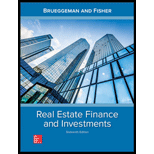
a.
To calculate: Monthly payments.
a.
Explanation of Solution
Formula to calculate monthly payment is as follows:
b.
To calculate: Interest and principle payments during month 1.
b.
Explanation of Solution
Formula to calculate interest is as follows:
Substitute equation with $80,000 for principle, 6% for interest rate to calculate interest.
Calculation of monthly payment during month 1 is as follows:
Substituting equation with 515.44 for monthly payment and $400 for interest to calculate payment during month 1.
c.
To calculate: Total principle and total interest paid over 25 years.
c.
Explanation of Solution
Formula to calculate total payment is as follows:
Substituting equation with $515.44 for monthly payment to calculate total payments.
Total payment is $154,632.
Formula to calculate total interest payment is as follows:
Substituting equation with $154,632 for total payments and $80,000 for principle payments to calculate total interest payment.
d.
To determine: Outstanding loan balance if the loan is repaid at the end of year 10.
d.
Explanation of Solution
Formula to calculate
Substituting equation with $80,000 for
e.
To calculate: Total monthly interest and principle payments through 10 years.
e.
Explanation of Solution
Formula to calculate total interest payment is as follows:
Substituting equation with $515.44 for monthly interest and 120 for n to calculate total payment.
Formula to calculate total principle payment is as follows:
Substituting equation with $80,000 for loan amount and $61,081.77 for present value to calculate total principle payment.
Formula to calculate total interest payment is as follows:
Substituting equation with $61,852 for total payments and $18,918.23 for total principle payment to calculate total interest payment.
f.
To calculate: Breakdown of interest and principle during month 50.
f.
Explanation of Solution
Present value of the outstanding loan at the end of month 49 is $73,608.28, formula to calculate interest payment is as follows:
Substituting equation with $73,608.28 for outstanding loan and 0.50% for the interest rate.
Formula to calculate principle payment is as follows:
Substituting equation with $515.44 for total payment and $368.04 for interest payment to calculate principle payment.
Want to see more full solutions like this?
Chapter 4 Solutions
Real Estate Finance And Investments
- critically discuss the hockey stick model of a start-up financing. In your response, explain the model and discibe its three main stages, highlighting the key characteristics of each stage in terms of growth, risk, and funding expectations.arrow_forwardSolve this problem please .arrow_forwardSolve this finance question.arrow_forward
- solve this question.Pat and Chris have identical interest-bearing bank accounts that pay them $15 interest per year. Pat leaves the $15 in the account each year, while Chris takes the $15 home to a jar and never spends any of it. After five years, who has more money?arrow_forwardWhat is corporate finance? explain all thingsarrow_forwardSolve this finance problem.arrow_forward
 Essentials Of InvestmentsFinanceISBN:9781260013924Author:Bodie, Zvi, Kane, Alex, MARCUS, Alan J.Publisher:Mcgraw-hill Education,
Essentials Of InvestmentsFinanceISBN:9781260013924Author:Bodie, Zvi, Kane, Alex, MARCUS, Alan J.Publisher:Mcgraw-hill Education,

 Foundations Of FinanceFinanceISBN:9780134897264Author:KEOWN, Arthur J., Martin, John D., PETTY, J. WilliamPublisher:Pearson,
Foundations Of FinanceFinanceISBN:9780134897264Author:KEOWN, Arthur J., Martin, John D., PETTY, J. WilliamPublisher:Pearson, Fundamentals of Financial Management (MindTap Cou...FinanceISBN:9781337395250Author:Eugene F. Brigham, Joel F. HoustonPublisher:Cengage Learning
Fundamentals of Financial Management (MindTap Cou...FinanceISBN:9781337395250Author:Eugene F. Brigham, Joel F. HoustonPublisher:Cengage Learning Corporate Finance (The Mcgraw-hill/Irwin Series i...FinanceISBN:9780077861759Author:Stephen A. Ross Franco Modigliani Professor of Financial Economics Professor, Randolph W Westerfield Robert R. Dockson Deans Chair in Bus. Admin., Jeffrey Jaffe, Bradford D Jordan ProfessorPublisher:McGraw-Hill Education
Corporate Finance (The Mcgraw-hill/Irwin Series i...FinanceISBN:9780077861759Author:Stephen A. Ross Franco Modigliani Professor of Financial Economics Professor, Randolph W Westerfield Robert R. Dockson Deans Chair in Bus. Admin., Jeffrey Jaffe, Bradford D Jordan ProfessorPublisher:McGraw-Hill Education





